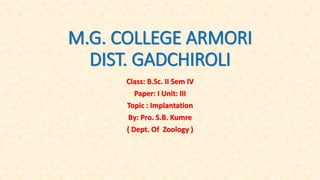
Implantation Process and Types
- 1. M.G. COLLEGE ARMORI DIST. GADCHIROLI Class: B.Sc. II Sem IV Paper: I Unit: III Topic : Implantation By: Pro. S.B. Kumre ( Dept. Of Zoology )
- 2. Implantation • The term implantation is used to describe the attachment of the developing embryo to the endometrium. • After fertilization the embryo reaches to the uterus in the blastocyst stage. Then attached to the wall of the uterus. Though the implantation may occur at any period between sixth to tenth day after the fertilization but generally it occurs on seventh day after fertilization. • It involves a receptive endometrium and hormonal factors such as estrogen, progesterone, prolactin as well as cell adhesion molecules, growth factors. • Further, the uterus is ready to accept the implanting embryo only during a limited period of time known as the ‘window of implantation’, outside of which the endometrium may be indifferent or even hostile to the embryo.
- 3. Process of Implantation • Implantation is a progressive and versatile process in which the blastocyst attaches and finally invades the underlying endometrial surface. • After fertilization and cleavage, the morula reaches the uterus between three or four days of development. • By the fifth day, blastocyst hatches out of the protecting zona pellucida by enzymatically boring a hole and squeezing itself out. • Adjacent cells of the endometrial stroma respond to the presence of the blastocyst and to the progesterone secreted by the corpus luteum by differentiating into metabolically active secretory cells called decidual cells. This response is termed as the decidual reaction. • Secretions of the decidual cells and endometrial glands include metabolites that support the growth of the implanting embryo. • Subsequently, the blastocyst attaches to the endometrial epithelium. • This is the initial phase of the implantation process called “adplantation”. This first phase requires the newly hatched blastocyst to loosely adhere to the endometrial epithelium, often “rolling” to the eventual site of implantation where it has firmly adhered.
- 4. Process of Implantation continue.. • As soon as it attaches, the trophoblast starts to proliferate rapidly and differentiate into: The inner layer of cytotrophoblast The outer layer of syncytiotrophoblast • The finger like processes of the syncytiotrophoblast extend through the endometrial epithelium and invade the connective tissue. • By the end of the first week, the blastocyst is superficially implanted in the compact layer of the endometrium. • Subsequently, the uteroplacental circulation develops with the formation of lacunar networks and villi.
- 6. Major Events in Implantation • Major Events in Implantation • Day 5: The zona pellucida degenerates. • Day 6: Blastocyst adheres to the endometrial epithelium. • Day 7: Trophoblast differentiates into two layers: syncytiotrophoblast and cytotrophoblast. • Day 8: Synctiotrophoblast erodes endometrial tissues, and the blastocyst starts to embed in the endometrium. • Day 9: Blood filled lacunae appear in syncytiotrophoblast • Day 10: Blastocyst sinks beneath the endometrial epithelium and defect is filled by a closing plug • Day 10 and 11: Lacunar networks form by fusion of adjacent lacunae • Day 11 and 12: The syncytiotrophoblast erodes endometrial blood vessels, allowing maternal blood to seep in and out of lacunar networks, thereby establishing a uteroplacental circulation • Days 12 and 13: The defect in the endometrial epithelium is repaired • Days 13 and 14: Primary chorionic villi develop • The implanted 12-day embryo produces a minute elevation on the endometrial surface that protrudes into the uterine lumen.
- 7. Types of Implantation 1) Interstitial Implantation 2) Eccentric Implantation 3) Centric or Superficial Implantation
- 8. • Interstitial Implantation : The form of implantation differs from one species to another. In primates and guinea pigs, the blastocyst burrows through the uterine epithelium to the uterine stroma where the embryo develops. This form of implantation is referred to as interstitial implantation.
- 9. • Eccentric Implantation : In rodents, implantation involves the blastocyst becoming lodged in a uterine cleft with proliferation of the surrounding uterine mucosa. This form of implantation is known as eccentric implantation.
- 10. • Centric or Superficial Implantation: In horses, cattle, sheep, pigs, dogs, cats and rabbits, the fluid‐filled sacs surrounding the embryo expand so that the extra‐embryonic membranes become apposed to the endometrium and attach to it. This form of implantation, the most common form of attachment in mammals, is referred to as centric or superficial implantation.
- 11. • Significance of Implantation • The implantation process allows the developing blastocyst to obtain nourishment and growth factors from the eroded maternal tissues. • If implantation has not proceeded sufficiently during the menstrual cycle to allow hormonal feedback to the ovary, then the next cycle may commence leading to conceptus loss. • A conceptus with major genetic defects does not develop or implant correctly leading to their loss during the first and second weeks of development. • In recent years with the development of Assisted Reproductive Technologies (ART or IVF) there is a growing interest in this process, with techniques that introduce the blastocyst into the uterus to allow normal implantation to occur.
- 12. Thank You